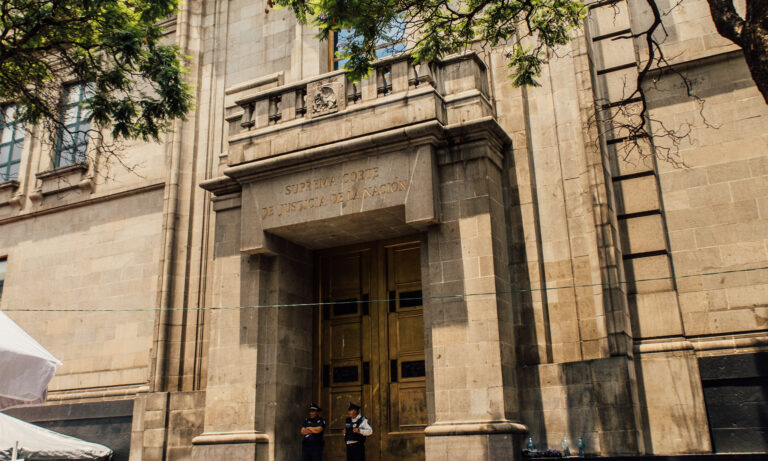MEXICO’S JUDICIAL ELECTION: JUSTICE DISTRIBUTED
This article by Arlin Medrano originally appeared in the May 31, 2025 edition of nodal.
Mexico has repeatedly shaped the political pulse of Latin America and the world. It was the first country to include fundamental social rights and recognition of Indigenous peoples in its 1917 Constitution, marking a historic advance in the fight for social justice. In 1943, it created the Mexican Social Security Institute (IMSS), an early example of universal public health care.
But it is also a country of emblematic resistance and struggles. In 1968, during the government of Gustavo Díaz Ordaz (1964-1970), thousands of university students mobilized to demand democracy, justice, and civil rights. This protest, known as the “Student Movement of ’68,” was brutally repressed in the Tlatelolco massacre, an event that marked a turning point in social policy and the struggle for democracy in Mexico and Latin America.
Now, in June 2025, Mexico opens a new and revolutionary chapter: for the first time, citizens will be able to directly elect, through six ballots, judges, magistrates, and ministers of the Supreme Court of Justice of the Nation (SCJN), the country’s highest court, representing a total of 881 positions.
This decision responds to the political and social circumstances currently facing Mexico, a country where historical progress coexists with profound shortcomings. Although the functioning of the Mexican state is based on three main pillars—the Executive, Legislative, and Judicial—one of them has not only ceased to function, but has also failed to respond to the social demands and urgent needs of the present. It is unsustainable.

A constitutional reform was initiated by Andrés Manuel López Obrador, former president of Mexico from 2018 to 2024, and revived by Mexico’s first female president, Claudia Sheinbaum, who is in office from 2024 to 2030. The reform was approved by the Congress of the Union, composed of the Senate and the Chamber of Deputies. In other words, the judiciary was reformed at the initiative of the executive branch and with the approval of the legislative branch. Now this constitutional reform has become law and a reality.
This process represents a profound blow to the political and judicial model inherited from neoliberalism, which locked the justice system into shadowy offices where political and economic elites, with the complicity of criminal groups, wove networks of impunity, nepotism, and privilege. For decades, the appointment of judges was in the hands of the Executive Branch and the Senate, excluding the voice of the people and allowing the consolidation of opaque and self-referential structures that alienated the social majority from justice.
The structural impunity that permeates the system is alarming. According to data from the National Autonomous University of Mexico (UNAM), the so-called “black figure”—crimes that go unreported—accounts for approximately 75% of the total. Of the crimes that are reported, only 1.06% result in a judicial conviction, meaning that 99% of crimes go unpunished. This is also a warning to prosecutors, a pending issue in our country.
The emblematic cases that highlight this crisis are painful. Marisela Escobedo, a Mexican activist, was murdered in front of the Chihuahua Government Palace in 2010 after denouncing the impunity in the case of the femicide of her daughter Rubí Frayre. Despite the murderer pleading guilty before a judge, he was released, exposing the system’s failure to protect victims and punish those responsible.

Another emblematic case is the tragedy at the ABC Daycare Center in Sonora, which occurred in 2009, during the administration of former President Felipe Calderón (2006-2012). A fire at a daycare center subcontracted by the Mexican Social Security Institute (IMSS)—which operated in a warehouse lacking minimum safety standards—caused the deaths of 49 children and injured more than 100. Despite the seriousness of the incident, the judiciary covered up the responsibility for those responsible, who had family ties to then-President Calderón and his wife, Margarita Zavala. To date, no one has been punished.
Furthermore, more than 86,000 people remain in prison without sentencing, many for minor offenses and without access to adequate defense, which constitutes a serious violation of the right to due process.
The popular election of judges seeks to break this structure of impunity and elitism. The idea that justice should be left solely in the hands of “technical experts” has been a lie of the neoliberal system that has served to protect the powerful and criminals, such as Genaro García Luna, former Secretary of Public Security of Mexico (2006-2012), currently sentenced in the United States for ties to drug trafficking and organized crime.
For the first time, this reform guarantees gender parity in the judiciary, an essential achievement in a country where, according to the National Human Rights Commission (CNDH), more than 80% of victims of sexual violence are women. This is not just about symbolic representation, but about changing from within patriarchal structures that have minimized violence against women.
At the global level, Mexico is positioned as a pioneer in democratizing justice. Although some countries—such as the United States (43 of 50 states), Bolivia, and Switzerland—elect their judges by popular vote, the difference is that Mexico will do so for all judicial positions.
Of course, there are risks, and these can be mitigated with clear regulations, rigorous technical requirements, and the active demands of citizens and social movements demanding real justice.
The current judiciary fails to deliver justice; it administers impunity, institutionalized sexism, racism, and cowardice. This reform won’t magically solve all the structural problems, but it is a deep crack in the wall of opacity and abuse.
For those calling for people not to vote on licensed television stations, from political party leaders to the very Congress that approved the judicial reform, it’s worth remembering that they are among those who have benefited from the current conditions. The real redistribution of the administration of justice frightens them, because for the first time they could face the full force of the law.
The redistribution of the administration of justice, above all, will make us pioneers.
-
Supreme Court Will No Longer be Held Hostage
Mexico’s incoming Supreme Court Chief Justice Hugo Aguilar Ortiz says power groups persist within the judiciary, and that monitoring and sanctions are urgently needed, otherwise, within five years, vices will be widespread.
-
Morena Opposes Cap and Gown at Supreme Court of Justice
Senators presented a bill that eliminates the mandatory use of the cap and gown for Supreme Court justices, with the goal of “eradicating symbols” of remoteness and elitism from the country’s highest court.
-
The Ideological Custodians of a Dying Neoliberalism
A serious political movement that wants to transform working class conditions must face up to the obstacles placed in its path. Mexico’s old judiciary was such an obstacle, as are rearguard defenders of institutionalized corruption like the OAS and corporate pundits.




